
Today, online events producer Caleb Booker debuts a new video series devoted to, and filmed entirely inside, virtual worlds. The program, “Virtual Worlds Keynote,” is filmed in Second Life in front of a live studio audience. Well, virtually live.
The first guest is Jonena Relth, president of TBD Consulting Inc., who will be talking about how her company sold its real building and went virtual.

We asked Booker a few questions about his new program.
Q: Our readers are enterprise users interested in immersive virtual worlds. What will they gain from your program?
Booker: From the ground up this series is built to give solid solutions to real-world problems companies have every day. Each episode will feature a case study or “how-to†lesson that aims to show the practical benefits of using virtual environments as a tool, and what it takes to get real results. Over the course of planning the series it has taken the form of an outreach program for people who aren’t necessarily interested in virtual worlds yet, but just need a good solution to something they’re facing every day. I’ve been very adamant from the beginning that the episodes stay relatively short – in the 20 minute range – so that the recorded sessions can be easily passed around the office and fit in with presentations people are making internally. The end result, when you eventually look at the back catalog of the series, will be a big list of solutions that enterprise can pick up and run with right now.
Q: Virtual worlds often get a bad rap in the business community. They remind people of games, and some have a reputation for sexual content. How do you address this?
Booker: With a lot of understanding. The fact is that this stuff is pretty weird to those who aren’t already involved. Imagine seeing, for the first time, someone reading a book. You’d naturally ask them why in the world they’d gain information that way when they could much more easily ask an elder for advice. It would seem preposterous to go through all the training it takes to learn to read, only to find out that learning to write takes an entirely separate skill set. You’d likely accept any and all criticisms of this “reading†stuff so that you could get back to what you’re comfortable with.
The point is that every new technology takes a bit of faith, and that’s something we in the B2B community need to earn. I’m hoping to do this by having guests on the show that can demonstrate specific returns for the time and money invested in a virtual world project. We can only do that by speaking in the common language of business, rather than the techno-babble or religious “Cult of Web 2.0†speak that evangelists tend to gravitate toward.
That means saying in three dozen ways: “If you want X result, here’s Y method to accomplish that. Oh, and yes, that involves the use of virtual worlds.â€
Q: There’s been some recent turmoil in the sector. Forterra sold off OLIVE to SAIC after laying off half its staff. Oracle won’t support Project Wonderland anymore. On the consumer side, Metaplace folded, as did Google’s Lively. Is it even worth it for a company to look at virtual worlds right now?
Booker: This is actually the best possible time for companies to start getting involved. Costs are low, and some serious competitive advantages are to be had. However, let’s not confuse the plight of platforms with the companies that use them. Sure there are fewer platforms for the moment, but the companies that use them are more active than ever.
What we’re seeing with the attrition of these platforms is a combination of two things: experiments that ended, and computer nerds who didn’t necessarily have an interest in running a business. We technologists are in a big rush to see virtual world platforms mature. We want it all and we want it now. The fact is, though, that the formula for a perfect virtual environment doesn’t exist yet and there’s no real consensus on what it might look like when it does. Even though you can go out there and make something useful right now, the tech is only just beginning to find its legs.
So, a few platforms dropping off were inevitable. Expect one or two more to go this year. The other thing you can expect, however, is that many of the up-and-coming platforms will begin to attract a lot more attention. 3dxplorer, for instance, is making some surprisingly big waves with big corporate names. The landscape is still full of small start-ups like ASSEMB’LIVE that could be game-changers.
The fact is that the best is yet to come, and those who move right now will have a seriously strong advantage over their competitors when the technology comes to full maturation.
Q: There was a lot of hype a couple of years ago about companies coming into Second Life, and this hype has mostly died down. Is that because there isn’t really any demonstrable ROI (return on investment) here?
Hype drives sales, but it has absolutely nothing to do with what people are actually doing. For that, you need to take a closer look.
I’ve been spending a lot of time speaking with developers over the last few weeks, and they list one common complaint: they can’t talk about their clients. In fact, the bigger the client, the less they can say.
I’ve shared this experience, and when you think about it this makes a lot of sense. Firstly, their legal department wants to make sure their brand name isn’t being abused by you. Its far easier for them to say no than figure out what the customized non-disclosure agreement should look like to allow you a little room at minimal risk.
The other big concern companies have is the competitive advantage. The more they see big returns from their virtual environments, the less they want to encourage competitors to do the same.
I will say this though: hype or no hype, there are a number of very busy developers in virtual environments right now servicing the Fortune 100 and 500 sector. I’m seeing more activity than ever before.
Q: Think ten years in the future. How will immersive virtual environments change the way we do business?
The biggest reason telecommuting isn’t more common, despite how easy and cost-effective it is, is that for practical business communications you need to feel like there’s nothing standing between yourself and the person you’re dealing with. An immersive virtual environment vaults over that hurdle quite handily, so expect a big upsurge in employees working from home.
There are some applications of virtual environments that are, right now, so effective that I can’t imagine a future where they aren’t the de facto solution. Things like training, data visualization, and coordinating emergency response efforts will simply be regarded as essentially virtual environment applications.
Large conferences or expos without a virtual component will be looked at as ludicrous, frankly. This will also be the dawn of the “Mega-Eventâ€. Things like E3 and Comic-Con will be understood to be events with several hundred thousand, attendees – mostly virtual. Meanwhile, a company considering holding an event without a virtual component will see a drop in stock price, as clearly they’re just throwing money out the window.
I’ve said it before and I’ll say it again: yes, the world is changing at a breakneck pace, but we haven’t seen anything yet.
Event details: Virtual Worlds Keynote debuts on Monday, February 15 at 4pm PST in Second Life by clicking here: http://slurl.com/secondlife/Tropical%20Treet/66/224/23
A recording of the show will be available at business.treet.tv/shows/virtual-keynote in the next few days.
- OSgrid back online after extended maintenance - April 16, 2025
- Analysts predict drop in headset sales this year - March 25, 2025
- OSgrid enters immediate long-term maintenance - March 5, 2025
